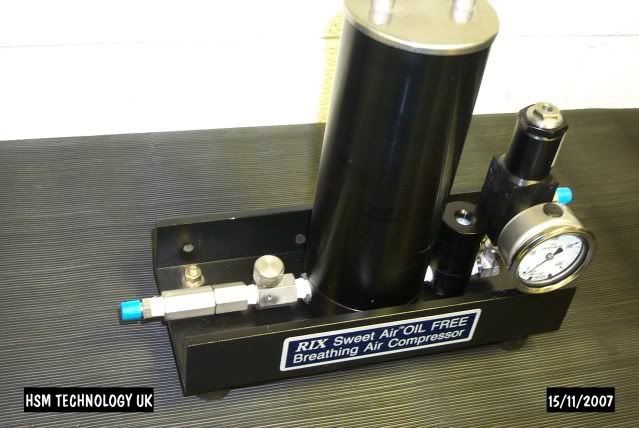To answer some of your questions and for balance.
On the mechanical filtration side:
1. The Rix SA-6E (works built) is an oil-free, oil-less air compressor it has three particulate filters fitted as standard.
One on the air inlet side, as a general purpose particulate and pollen intake filter with two additional filters interstage
Both are a dutch mesh 10 mu stainless type filter type fitted after 2nd and 3rd stage. Three filters fitted as standard.
The EU Nitrox has an additional 2mu sintered bronze filter on the discharge side making a total of
four particulate mechanical filters fitted prior to any chemical filter tower.
2. Most chemical filter towers typically have "felt pads" some use sponge but these are simply to hold the
chemical in place in the column. However on the Rix filter system these are 7mm deep and each 10 mu
polyester weave and again on the discharge side using a long stainless body final filter with a sintered
bronze 2mu cone type 0-ring sealed filter element.
2. The measured particulate contamination from ring wear is further reduced from getting inside the
compressor tubing and from contaminating downstream pipework by the open piston back rod end
design and a rider rings acting additionally as a wiper rings on each stage wiping the piston bore
clean on the return stroke of any PTFE that doesn't stick to the piston liner.
There is therefore less measured contamination from your SA-6 without additional chemical filtration
that from most other small oil lubricated scuba compressors with filtration.
On the air purity side.
1. There has been some confusion over this filter or no filter with sports divers I believe this started
with the US Navy Seal teams using the Rix SA-6 without any additional chemical filter towers.
For a proof or purity test. We also fill without filters for potential customers to try into our own aluminium
cylinders and for them to take a trial dive as a "suck it and see" without filters. The use is always with aluminium cylinders.
When using steel cylinders a small fitter tower acting as a dehydrator with molecular sieve is used to reduce dewpoint.
With the SA-6G seal team builds the use of aluminium cylinders is essential as only water condensate has been
removed by the separators and the water vapour has NOT been reduced. This was part of the design for a particular application.
Granted an oil less system also cools the gas coils rapidly as your not trying also to cool a bucket full of hot oil, but water
vapour will condense without an additional chemical dehydrator.
Out of interest the discharge from the compressor is simply pure distilled water, nothing else.
It is perfectly safe to drink, water your plants with or use topping up car batteries with.
Critically it is perfectly safe to discharge down a public sewer or rain fall system, something that is banned un the UK with a
conventional oil lubricated compressor with its emulsified oil and water mixture.
But for diving purposes an additional dehydrator chemical filter is needed
save for two points, when using this small 18" tower you bought assuming its a black hard anodised and 3.750" in OD diameter.
Using a 2.5 inch diameter filter cartridge.
1. Only needs to be filled with molecular sieve,
2. Fit a visual humidity indicator and a back pressure regulator in that order downstream on the outlet
Activated charcoal, or activated carbon on a Rix is a waste of time and frankly a risk and it reduces performance duration.
If a catalytic converter CO removing chemical is needed its when using a petrol or gas engine drive and for that we
recommend an additional 10" tower of the same 3.75" diameter filled purely with Hopkalite downstream at the
dry end, with a filter change every two years or 1000 hours.
IMHO Don't mix Hopkalite with AC and MS in the same tower, its a cheap trick, it is a waste of money and
adds risk even more so on a conventional oil lubricated compressor.
A photo of the 10" filter is below for reference (set up as a small filter system) Iain Middlebrook








